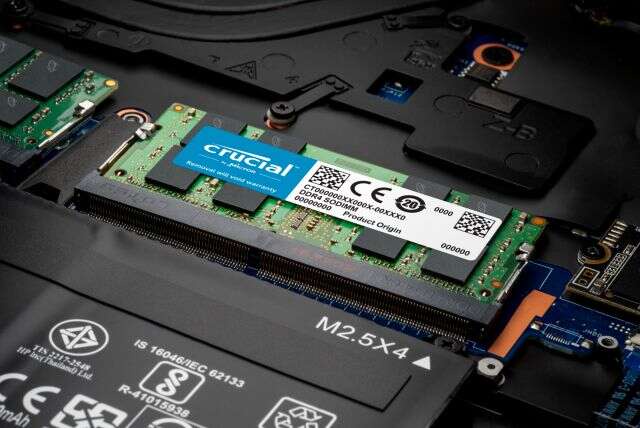Your laptop feels sluggish. Programs take forever to load, web browsing is a stuttering mess, and multitasking is a distant memory. These are all classic signs that your laptop's performance is suffering. While there can be several culprits behind slowdowns, insufficient RAM (Random Access Memory) is often a prime suspect. But before you rush out and buy more RAM, it's crucial to understand if a RAM upgrade is the solution you need.
This blog dives into the world of RAM and explores how adding more can potentially boost your laptop's performance. We'll discuss what RAM does, how much you need, compatibility considerations, and the installation process (though for a risk-free upgrade, seeking professional help from a trusted laptop repair service might be preferable). Finally, we'll explore some alternative solutions if a RAM upgrade isn't the answer.
Even if you're not comfortable tinkering with your laptop's internals, this information will equip you to make informed decisions about your device's performance. However, if you're interested in acquiring the skills to diagnose and troubleshoot laptop issues, consider enrolling at a laptop repairing institute in Delhi like Hi-Tech Institute, established in 2004, have trained over 3 lakh students in laptop and mobile repair. Their comprehensive courses can equip you with the knowledge and practical experience to confidently handle laptop upgrades and repairs.
Here are eight key points to consider when evaluating a potential RAM upgrade for your laptop:
1. Understanding RAM:
RAM is your laptop's short-term memory. Think of it as a workspace where actively used applications and data are stored for quick access. The more RAM you have, the more information your laptop can readily access, leading to faster performance. With insufficient RAM, your laptop resorts to using the much slower hard drive or solid-state drive (SSD) for temporary storage, causing performance bottlenecks.
2. Signs of Low RAM:
Several symptoms can indicate insufficient RAM:
- Slow Startup and Shutdown: Your laptop takes an unusually long time to boot up or shut down.
- Slow Program Loading: Applications take forever to launch and become unresponsive.
- Lag and Stuttering: Web browsing is sluggish, and tasks like video editing or gaming become frustratingly slow.
- Frequent Freezing: Your laptop freezes or crashes unexpectedly.
3. How Much RAM Do You Need?
The ideal amount of RAM depends on your typical usage. For basic tasks like web browsing and email, 4GB of RAM might suffice. However, for moderate multitasking, content creation, and gaming, 8GB is the new standard. If you're a power user working with demanding applications like video editing or 3D modeling, 16GB or even 32GB of RAM can significantly improve performance.
4. Checking Your Current RAM:
Before considering an upgrade, determine your current RAM capacity. This information can usually be found in your laptop's manual or by accessing system settings.
5. RAM Compatibility:
Not all RAM is created equal. When upgrading, ensure the new RAM modules are compatible with your laptop's motherboard and processor. You'll need to consider factors like RAM type (DDR3, DDR4, etc.), speed (MHz), and number of pins. Consulting your laptop's manual or manufacturer's website is crucial before purchasing RAM.
6. Upgrading Your RAM:
Upgrading RAM can be a relatively straightforward process for those comfortable opening their laptop. However, if you're unsure about the steps involved, seeking help from a qualified technician is recommended. Institutes like Hi-Tech Institute in Delhi can provide valuable guidance or even offer professional RAM upgrade services.
7. Alternative Solutions for Improving Performance:
While a RAM upgrade can be a performance booster, it's not always the only solution. Here are some alternatives to consider:
- Free Up Disk Space: A cluttered hard drive can slow down your laptop. Delete unnecessary files, uninstall unused programs, and consider using a disk cleaning tool.
- Disable Startup Programs: Many programs automatically launch at startup, consuming resources. Disable unnecessary programs in your system settings to improve boot time and overall performance.
- Consider a Solid-State Drive (SSD): If your laptop uses a traditional hard drive, upgrading to an SSD can significantly improve performance across the board.
8. Conclusion:
Upgrading your RAM can be a cost-effective way to breathe new life into your laptop, especially if you're experiencing performance issues due to insufficient memory. By understanding RAM's role, assessing your needs, and ensuring compatibility, you can make an informed decision about upgrading. However, if you're uncomfortable with the process or require further guidance, consider seeking professional help. Institutes like Hi-Tech Institute in Delhi offer laptop repairing courses that can equip you with the skills and knowledge to tackle laptop upgrades and repairs confidently. Their 20-year legacy of training over 3 lakh students speaks volumes about their expertise.
The laptop repair industry is projected to need a staggering 10 lakh laptop repair engineers, and the skills gained through a laptop repairing course in Delhi can open doors to a rewarding career path. With the potential to earn 40,000 to 50,000 rupees monthly, this field offers both financial security and the satisfaction of helping others keep their laptops running smoothly. So, whether you're looking to optimize your own laptop's performance or considering a career change, explore the possibilities and take control!


No comments yet